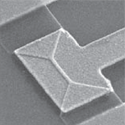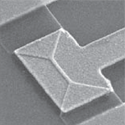Mind the graphene gap
Graphene is a promising material for engineering novel electronic devices, but this promise comes with puzzles, many of which have to do with its unique band structure. In its basic form, graphene does not have an energy gap, which is an essential ingredient for making electronic devices. However, it is possible to induce a gap, and tweak its width and other properties, by carving graphene into certain geometries. In an earlier paper [1], Philip Kim and colleagues at Columbia University in the US showed that it was possible to induce a gap in nanoribbons of graphene. The gap’s width was inversely proportional to that of the ribbon.
In a follow-up article appearing in Physical Review Letters, Kim, with Melinda Han and Juliana Brant, who are also at Columbia, go a step further and study charge transport in graphene nanoribbons with a range of widths and lengths at different temperatures. Their detailed characterization—of scaling properties, charging effects, the effect of disorder, etc.—should help us understand the nature of the energy gap in graphene nanostructures and bring us close to realizing graphene-based electronic devices. – Sami Mitra
[1] M. Y. Han et al., Phys. Rev. Lett. 98, 206805 (2007).





